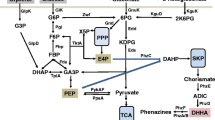Abstract
The glycopeptide antibiotic A82846B (chloroeremomycin) produced by Amycolatopsis orientalis is the precursor of the semi-synthetic antibiotic oritavancin. However, during the industrial production of A82846B, two major impurities, A82846A (63.6%) and A82846C (12%) which are structurally similar to A82846B (24.4%), are also produced. In this study, to improve the ratio of A82846B to A and C, the genes encoding halogenase in A82846B and vancomycin synthesis were integrated into A. orientalis SIPI18099 to test their halogenation ability, respectively. The results indicated that chal from the A82846B biosynthesis pathway was more efficient in reducing A and C factors. Moreover, by increasing the chal copy number, the proportion of A and C were gradually reduced while the titer and proportion of A82846B were improved. In a scaled-up industrial process, the proportion of A and C were decreased to 11.6% and 0.2% in the recombinant strain A.orientalis chal-3 with three gene copies of chal and the titers of A82846B (2.2 g/L) has increased by 2.8-folds compared to 780 mg/L produced by the parental strain, suggesting that the recombinant strain was suitable for the industrial production of A82846B with lower impurities.







Similar content being viewed by others
References
Arthur M, Courvalin P (1993) Genetics and mechanisms of glycopeptide resistance in enterococci. Antimicrob Agents Chemother 37:1563–1571
Bierman M, Logan R, O'Brien K, Seno ET, Rao RN, Schoner BE (1992) Plasmid cloning vectors for the conjugal transfer of DNA from Escherichia coli to Streptomyces spp. Gene 116(1):43–49
Brade KD, Rybak JM, Rybak MJ (2016) Oritavancin: a new lipoglycopeptide antibiotic in the treatment of gram-positive infections. Infect Dis Ther 5(1):1–15
Chang S, Sievert DM, Hageman JC, Boulton ML, Tenover FC, Downes FP, Shah S, Rudrik JT, Pupp GR, Brown WJ, Cardo D, Fridkin SK (2003) Infection with vancomycin-resistant staphylococcus aureus containing the vanA resistance gene. N Engl J Med 348(14):1342–1347
Corey GR, Kabler H, Mehra P, Gupta S, Overcash JS, Porwal A, Giordano P, Lucasti C, Perez A, Good S, Jiang H, Moeck G, O'Riordan W (2014) Single-dose oritavancin in the treatment of acute bacterial skin infections. N Engl J Med 370(23):2180–2190
Dorrestein PC, Yeh E, Garneau-Tsodikova S, Kelleher NL, Walsh CT (2005) Dichlorination of a pyrrolyl-S-carrier protein by FADH2-dependent halogenase PltA during pyoluteorin biosynthesis. Proc Natl Acad Sci U S A 102(39):13843–13848
Edelsberg J, Weycker D, Barron R, Li X, Wu H, Oster G, Badre S, Langeberg WJ, Weber DJ (2014) Prevalence of antibiotic resistance in US hospitals. Diagn Microbiol Infect Dis 78(3):255–262
Gerhard U, Mackay JP, Maplestone RA, Williams DH (1993) The role of the sugar and chlorine substitutes in the dimerization of vancomycin antibiotics. J Am Chem Soc 115(1):232–237
Hamill RL, Mabe JA, Mahoney DF, Nakatsukasa WM, Yao RC (1998) A82846 antibiotics. US Pat NO.005843437A
Harris CM, Kannan R, Kopecka H, Harris TM (1985) The role of the chlorine substituents in the antibiotic vancomycin: preparation and characterization of mono-and didechlorovancomycin. J Am Chem Soc 107(23):6652–6658
Hubbard BK, Walsh CT (2003) Vancomycin assembly: nature’s way. Angew Chem 42(7):730–765
Kaatz GW, Seo SM, Aeschlimann JR, Houlihan HH, Mercier RC, Rybak MJ (1998) Efficacy of LY333328 against experimental methicillin-resistant staphylococcus aureus endocarditis. Antimicrob Agent Chemother 42(4):981–983
Kieser T, Bibb MJ, Buttner MJ, Chater K, Hopwood DA (2000) Practical Streptomyces genetics: a laboratory manual. The John Innes Foundation, Norwich
Leadbetter MR, Linsell MS, Lee J, Liu J (2010) Process for preparing glycopeptide phosphonate derivatives. US Pat NO.7728104B2
Lee KS, Lee BM, Ryu JH, Kim DH, Kim YH, Lim S-K (2016) Increased vancomycin production by overexpression of MbtH-like protein in Amycolatopsis orientalis KFCC10990P. Lett Appl Microbiol 63(3):222–228
Li TL, Huang F, Haydock SF, Mironenko T, Leadlay PF, Spencer JB (2004) Biosynthetic gene cluster of the glycopeptide antibiotic teicoplanin: characterization of two glycosyltransferases and the key acyltransferase. Chem Biol 11(1):107–119
Olano C, Lombó F, Méndez C, Salas JA (2008) Improving production of bioactive secondary metabolites in Actinomycetes by metabolic engineering. Metab Eng 10(5):281–292
Puk O, Huber P, Bischoff D, Recktenwald J, Jung G, Süssmuth RD, Pée KH, Wohlleben W, Pelzer S (2002) Glycopeptide biosynthesis in Amycolatopsis mediterranei DSM5908: function of a halogenase and a haloperoxidase/perhydrolase. Chem Biol 9(2):225
Puk O, Bischoff D, Kittel C, Pelzer S, Weist S, Stegmann ED, Süssmuth R, Wohlleben W (2004) Biosynthesis of chloro-beta-hydroxytyrosine, a nonproteinogenic amino acid of the peptidic backbone of glycopeptide antibiotics. J Bacteriol 186(18):6093–6100
Rafai FA, Krishna G, Ding M, Chemburkar SR, Knable CM, Petzel JJ, Pruyne JJ, Reamer DM (2016) High purity Oritavancin and method of producing same. WO Pat No.2016011245 A1
Rupp ME, Fey PD, Longo GM (2001) Effect of LY333328 against vancomycin-resistant enterococcus faecium in a rat central venous catheter-associated infection model. J Antimicrob Chemother 47(5):705–707
Sambrook J, Russell DW (2001) Molecular cloning: a laboratory manual, 3rd edn. Cold Spring Habor Laboratory Press, Cold Spring Habor
Shao L, Huang J, Jing L, Chen J, Kan S, Wang M, Li J, Chen D (2010) Overexpression of aveBIV leading to the improvement of 4′-epidaunorubicin production in Streptomyces coeruleorubidus strain SIPI-A0707. Appl Microbiol Biotechnol 87(3):1057–1064
Van Wageningen AM, Kirkpatrick PN, Williams DH, Harris BR, Kershaw JK, Lennard NJ, Jones M, Jones SJ, Solenberg PJ (1998) Sequencing and analysis of genes involved in the biosynthesis of a vancomycin group antibiotic. Chem Biol 5(3):155–162
Xu L, Huang H, Wei W, Zhong Y, Tang B, Yuan H, Zhu L, Huang W, Ge M, Yang S, Zheng H, Jiang W, Chen D, Zhao G, Zhao W (2014) Complete genome sequence and comparative genomic analyses of the vancomycin-producing Amycolatopsis orientalis. BMC Genomics 15(1):363
Author information
Authors and Affiliations
Corresponding author
Ethics declarations
Conflict of interest
The authors declare that they have no conflict of interest.
Ethical approval
This article does not contain any studies with human participants or animals performed by any of the authors.
Rights and permissions
About this article
Cite this article
Wang, WY., Yang, SB., Wu, YJ. et al. Enhancement of A82846B yield and proportion by overexpressing the halogenase gene in Amycolatopsis orientalis SIPI18099. Appl Microbiol Biotechnol 102, 5635–5643 (2018). https://doi.org/10.1007/s00253-018-8983-8
Received:
Revised:
Accepted:
Published:
Issue Date:
DOI: https://doi.org/10.1007/s00253-018-8983-8




